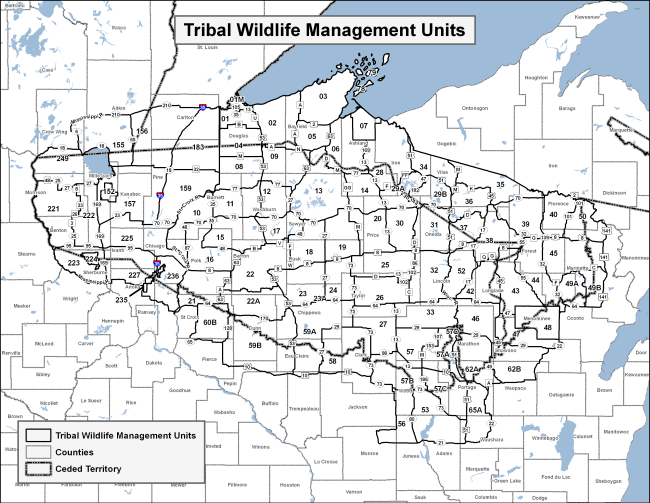Seasonal waawaashkeshi (deer) hunting regulations and information.
In addition to general harvest regulations, the following provisions apply during the deer hunting seasons in the 1837 and 1842 Ceded Territories in Wisconsin and Minnesota.
This page does not detail harvest regulations in their entirety. Additionally, your Tribe may have more restrictive regulations. Check with your Tribe for their full code of regulations.
Wisconsin 1837 and 1842 Ceded Territories
- Day after Labor Day to January 31st.
- 1/2 hour before sunrise to 20 minutes after sunset
Some Band’s deer season goes through the 1st Sunday after the 1st Saturday in January; check with your tribal conservation department to verify the length of your Tribe’s season.
Minnesota 1837 Ceded Territory
- Day after Labor Day to December 31st.
- 1/2 hour before sunrise to 1/2 hour after sunset

In most years there are no tribal antlerless deer quotas, and there shall be no limit on the number of antlerless deer available for harvest. However, when tribal quotas are required, they are determined annually. Quota information is available from your Band’s conservation department, registration station, or GLIFWC.
No member may hunt deer without possessing a valid permit/stamp. Unit-specific permits/stamps may be issued in years when antlerless deer quotas are necessary. Permits/stamps, or tags can be obtained from your Band’s conservation department or registration station. In addition, you may be able to obtain them from another Band’s conservation department or registration station if that Band has enacted an ordinance similar to your Band’s.
No more than four (4) deer stamps may be issued to a member at a time. Members must follow all weapon and area restrictions included in their Tribe's code.
A carcass tag is not required, however, if you leave a carcass unattended in the field, attach a tag to the carcass with your NAGFA ID and stamp #.
Registration is required. Deer can be registered by phone at 1-844-234-5439, online at glifwc.nagfa.net/online, in the field by a GLIFWC warden, or in-person at a tribal registration station. Deer must be registered in-person by 5:00 pm on the 3rd working day after harvest; the registration deadline for phone, online, or by a GLIFWC warden is 5:00 pm the day after harvest.
When you register, you will need your NAGFA ID, stamp #, date of harvest, type of deer, unit, and county of harvest.
If your Band has approved commercial deer hunting, special rules apply; contact your Band’s conservation department, registration station, or GLIFWC with questions.
You must successfully complete an advanced hunter safety education course, receive marksmanship training, and pass a marksmanship test to be eligible for a night hunting permit. There are limited opportunities to hunt deer at night, with a special permit. For more information on hunter's education, contact your Band’s conservation department, registration station, or GLIFWC.
Wisconsin 1837 and 1842 Ceded Territories
- You may hunt deer 1 hour after sunset to 1 hour before sunrise, WITH a night hunting permit, a signed certified shooting plan, and a Tribal ID.
- You must submit a shoot plan with a safe zone of fire identified to receive a night hunt permit.
- Warden approval is required for plans where the shooter is not elevated at least 10 ft. (ground blind); shoot plans and instructions are linked below.
- You may only discharge a weapon from the marked stationary position, within the established safe zone of fire with an adequate backstop, and in the direction of intended fire.
- You may pursue and kill a wounded deer, if you do not use a firearm, bow and arrow, or crossbow to kill it until legal daytime hunting hours.
- Hunting deer at night may not take place during the Wisconsin State regular gun deer season.
Minnesota 1837 Ceded Territory
- You may hunt deer at night from 1/2 hour after sunset to 1/2 hour before sunrise.
- Night hunting must take place at a pre-approved and inspected location; and from an elevated stand at least 10 ft. above the ground.
- You may only possess a loaded weapon at and shoot from the elevated stand.
- A battery-operated flashlight containing five D batteries with a krypton bulb is the only light that can be used.
- Firearms cannot have scopes, and you may only shoot at a deer that you are shining with the flashlight and is at the bait pile.
- You are limited to only one bait pile, placed within 17 yds. of the elevated stand; the bait pile cannot be larger than 16 sq. ft. or more than 4 ft. long on any side.
- You may pursue and kill a wounded deer, if you do not use a firearm to kill it until legal daytime hunting hours.
- Hunting deer at night may not take place during the Minnesota state regular firearm (not muzzleloader) season.
In addition to the special rules for shining deer and night hunting deer, all other rules that apply to deer hunting also still apply.